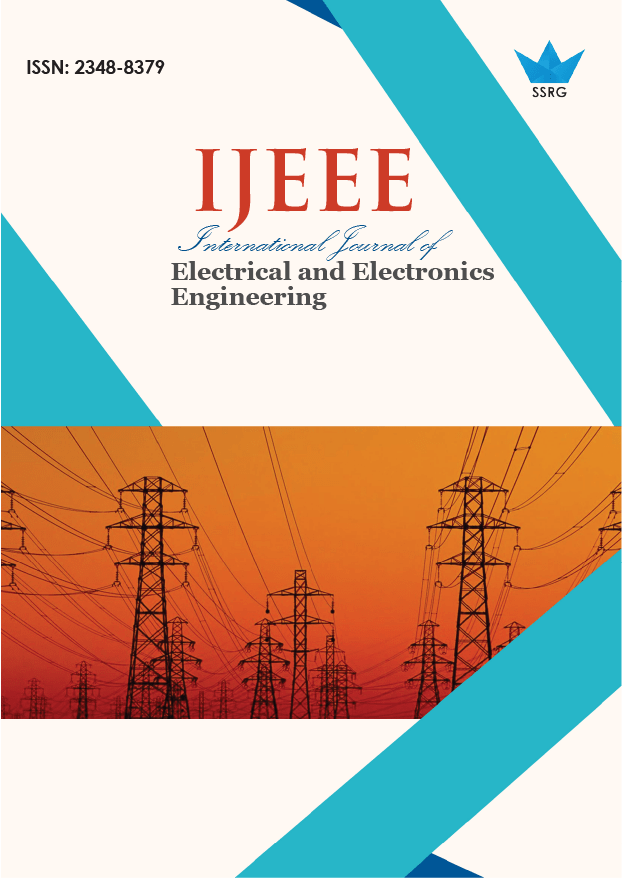Fault Detection and Location in Power Transmission Lines Using Labview

| International Journal of Electrical and Electronics Engineering |
| © 2021 by SSRG - IJEEE Journal |
| Volume 8 Issue 9 |
| Year of Publication : 2021 |
| Authors : N. Priya, Rajeshkumar. D, Mathavan. R, Kalieswari. G |
How to Cite?
N. Priya, Rajeshkumar. D, Mathavan. R, Kalieswari. G, "Fault Detection and Location in Power Transmission Lines Using Labview," SSRG International Journal of Electrical and Electronics Engineering, vol. 8, no. 9, pp. 1-4, 2021. Crossref, https://doi.org/10.14445/23488379/IJEEE-V8I9P101
Abstract:
Energy becomes the key to running household appliances of any sort. It's a challenge and life risky profession to work with electricity. The issue in distribution lines is normally just identified and reported to controller panels, but the serviceman responsible for the fault resolution must be alerted. The current is detected correspondingly by the current transformer. In order to monitor and regulate the failure of the transmission line, the power line information is forwarded to the EB office, and the power line is trimmed using the Zigbee transceiver module. In the case of fire/spark occurrence in the transmission line, a temperature and fire sensor is employed, and sensor readings are updated additionally to the EB Office. The power-sharing is carried out from the EB station during the power deficit. Only consumers may consume limited electricity. But if the electricity use reaches that amount. The EB station then triggers the power supply entirely.
Keywords:
EB, Transmission Line, Over Voltage.
References:
[1] Guarnieri, M., The Beginning of Electric Energy Transmission: Part One, IEEE Industrial Electronics Magazine. 7 (1) (2013) 57–60. doi:10.1109/MIE.2012.2236484.
[2] Kezunovic, M.: Smart fault location for smart grids, IEEE Trans. Smart Grid, 2 (2011) 11–22
[3] Ouyang, Y., He, J.L., Hu, J., et al.: A current sensor based on the giant magnetoresistance effect: design and potential smart grid applications, Sensors, 12 (2012) 15520–15541.
[4] Han, J.C., Hu, J., Yang, Y., et al.: A nonintrusive power supply design for self-powered sensor networks in the smart grid by scavenging energy from AC power line, IEEE Trans. Ind. Electron., 62 (2015) 4398–4407
[5] De La Ree, J., Centeno, V., Thorp, J.S., et al.: Synchronized phasor measurement applications in power systems, IEEE Trans. Smart Grid, 1 (2010) 20–27
[6] Bo, Q., Jiang, F., Chen, Z., et al.: Transient based protection for power transmission systems. IEEE Power Engineering Society Winter Meeting, (2000) 1832–1837.
[7] Yu, S.-L., Gu, J.-C.: Removal of decaying DC in current and voltage signals using a modified Fourier filter algorithm’, IEEE Trans. Power Deliv., 16 (2001) 372–379.
[8] Das, B., Reddy, J.V.: Fuzzy-logic-based fault classification scheme for digital distance protection, IEEE Trans. Power Deliv., 20 (2005) 609–616.
[9] Jamehbozorg, A., Shahrtash, S.M.: A decision-tree-based method for fault classification in single-circuit transmission lines’, IEEE Trans. Power Deliv., 25 (2010) 2190–2196.
[10] Jamehbozorg, A., Shahrtash, S.M.: A decision tree-based method for fault classification in double-circuit transmission lines, IEEE Trans. Power Deliv., 25 (2010) 2184–2189.
[11] Hagh, M.T., Razi, K., Taghizadeh, H.: Fault classification and location of power transmission lines using artificial neural network, 2007 Conf. Proc. IPEC, 1-3 (2007) 1109–1114.

 10.14445/23488379/IJEEE-V8I9P101
10.14445/23488379/IJEEE-V8I9P101